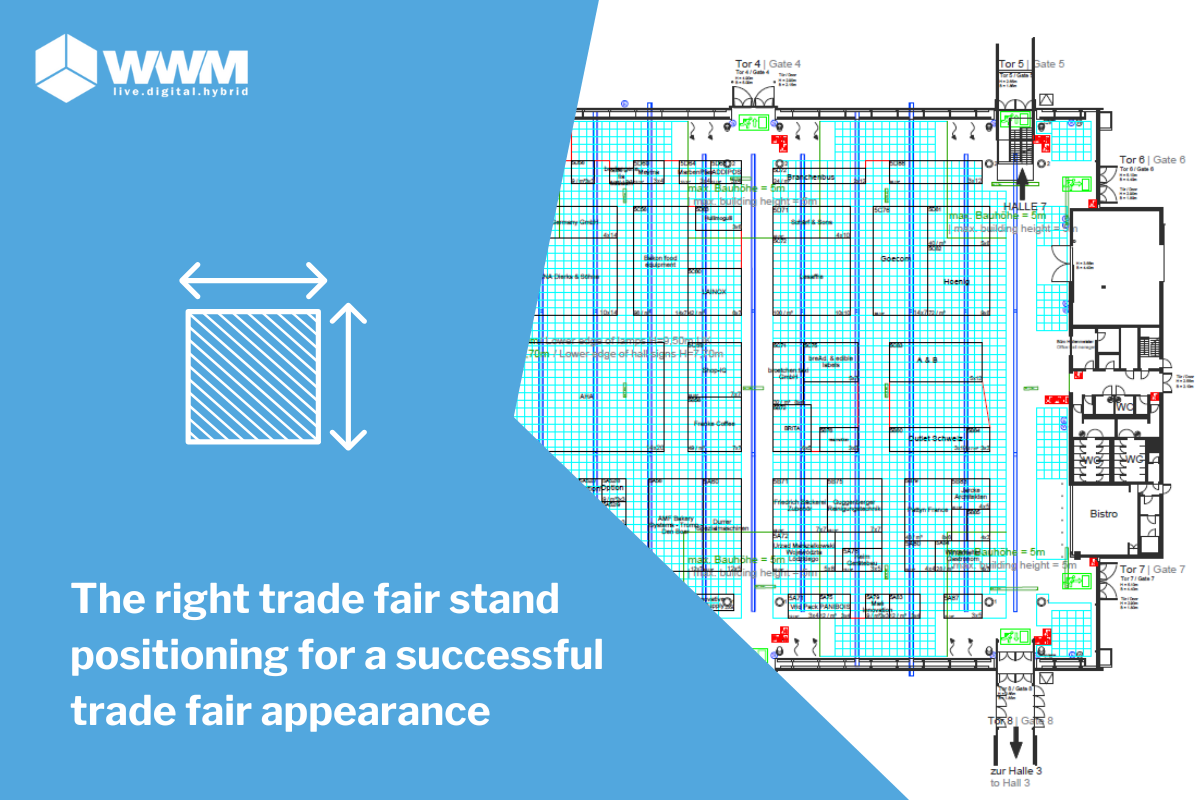Right trade fair stand positioning for successful trade fair appearances
Participating in a trade fair offers a unique opportunity to present your company, products or services to a wide audience. A successful trade fair...
5 min read
Maxima Matara
:
Friday, 9. August 2024

Trade fairs offer companies a first-class opportunity to present products and services, acquire new customers and make valuable business contacts. But an impressive trade fair appearance doesn't happen by itself; it requires precise planning and a strategic approach.
In our latest blog article, we present a comprehensive checklist that will guide you step by step through the entire trade fair planning process. This will ensure that your trade fair appearance not only runs smoothly, but is also a resounding success. Take the next step and take your trade fair appearance to the next level!

The first and decisive phase of trade fair planning is setting objectives. Without clearly defined objectives, there is a lack of orientation and your trade fair presence could fail to make an impact. It is therefore essential to define your specific objectives right from the start.
Think about what you want to achieve with your trade fair participation. Here are some potential goals to consider:
Set your goals SMART - specific, measurable, achievable, relevant and time-bound. This not only gives you clarity about your intentions, but also allows you to precisely evaluate the success of your trade fair participation. Go in with a clear plan and optimize your trade fair presence for maximum success!
Based on your defined goals, developing a well thought-out strategy is the next step for a successful trade fair appearance. Consider the following key factors:
Budgeting is a crucial step in trade fair planning. A precise budget protects you from financial surprises and creates a clear framework for your planning.
Take all the main cost factors into account when budgeting:
An additional financial buffer is recommended. This will help you to cover unforeseen expenses such as additional printing costs for materials or last-minute changes to the stand. By budgeting carefully and allocating resources wisely, you can ensure that your trade fair appearance is both efficient and successful.
Effective resource management is essential for a successful trade fair appearance. Ensure that your planning is precise and your resources are optimally deployed. Start by appointing a dedicated project team to carefully coordinate and oversee the trade fair planning. This team should have an overview of all aspects of the preparation and implementation of the trade fair appearance.
Make sure that you schedule enough qualified staff for the trade fair days. Each member of staff must know exactly what tasks they are expected to perform in order to ensure that everything runs smoothly at the stand. Clear responsibilities and efficient use of resources will ensure that your trade fair presence runs smoothly and that your goals are successfully achieved.
Your trade fair stand is the figurehead of your company and is decisive for the first impression you make on your visitors. A professionally designed stand not only attracts attention, but also conveys professionalism and seriousness.
Invest in an attractive and functional stand design that optimally represents your brand. Make sure that:
There is enough space for personal discussions: create quiet areas where you can talk to potential customers undisturbed.A well-equipped stand is essential for a professional appearance. Make sure that your stand has the necessary technical equipment to ensure a smooth and professional presentation:
Successful trade fair participation begins long before the actual event. Use various marketing channels to actively communicate your participation and activate your target group.
Use social media, e-mail campaigns, press releases and personal invitations to announce your presence at the trade fair at an early stage. These measures not only increase the visibility of your stand, but also arouse interest and mobilize potential visitors.
Plan your communication strategy for the trade fair precisely. Think about how you can effectively address trade fair visitors and direct their interest in a targeted manner. Use appealing giveaways, information material and interactive elements to leave a lasting impression.
Identify relevant topics for your target group and prepare to address them proactively and professionally.
Your trade fair staff are the key to the success of your presentation. Thorough training and precise briefing are therefore of central importance.
Ensure that your team is optimally informed and prepared:
Carry out a comprehensive briefing before the start of the trade fair. Clarify the daily schedule, responsibilities and internal communication channels. Ensure that every employee is informed about the latest information and offers and knows exactly how to respond to various questions and challenges.
The follow-up of your trade fair participation is crucial for long-term success and must not be neglected under any circumstances. This is where you lay the foundation for future success.
Systematically collect contact data during the trade fair and make a note of relevant conversations. This enables you to follow up in a targeted manner and develop valuable relationships. Prompt contact with the leads gained is essential in order to maintain and permanently activate the newly established contacts.
Carry out a comprehensive performance review to evaluate the achievement of your trade fair objectives. Analyze which strategies and measures were particularly successful and identify potential for improvement. Obtain feedback from your team and trade fair visitors in order to further optimize future trade fair appearances. Review what worked well and what you should do differently next time to maximize the effectiveness of your trade fair presence.
Successful trade fair planning is the key to an outstanding trade fair appearance and requires precise preparation, strategic thinking and exact execution. Our detailed checklist will help you to take all the decisive factors into account and optimize your trade fair participation. Remember: a trade fair is much more than just a stage to present your products - it is a valuable opportunity to build and strengthen business relationships. With well thought-out planning and targeted implementation, you are ideally equipped to present your company impressively and achieve long-term success. Use this opportunity to take your trade fair presence to the next level and ensure lasting positive results.

Participating in a trade fair offers a unique opportunity to present your company, products or services to a wide audience. A successful trade fair...

In exhibition stand construction, safety is no coincidence, but an essential prerequisite for a successful and professional presentation. Safety...

Between the peak phases of the trade fair world lies a time that is often underestimated - the trade fair break. But it is precisely now that it is...